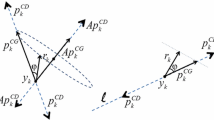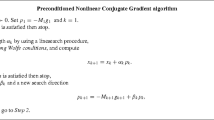Abstract
We propose a new and more stable variant of the CGS method [27] for solving nonsymmetric linear systems. The method is based on squaring the Composite Step BCG method, introduced recently by Bank and Chan [1,2], which itself is a stabilized variant of BCG in that it skips over steps for which the BCG iterate is not defined and causes one kind of breakdown in BCG. By doing this, we obtain a method (Composite Step CGS or CSCGS) which not only handles the breakdowns described above, but does so with the advantages of CGS, namely, no multiplications by the transpose matrix and a faster convergence rate than BCG. Our strategy for deciding whether to skip a step does not involve any machine dependent parameters and is designed to skip near breakdowns as well as produce smoother iterates. Numerical experiments show that the new method does produce improved performance over CGS on practical problems.
Similar content being viewed by others
References
R.E. Bank and T.F. Chan, A composite step bi-conjugate gradient algorithm for solving non-symmetric systems, UCLA CAM Tech. Report 93-21 (1993), Number. Algor., this issue.
R.E. Bank and T.F. Chan, An analysis of the composite step bi-conjugate gradient algorithm for solving nonsymmetric systems, UCLA CAM Tech. Report 92-53 (1992), Number. Math., to appear.
C. Brezinski and H. Sadok, Lanczos-type algorithms for solving systems of linear equations, Appl. Numer. Math. 11 (1993) 443–473.
C. Brezinski and H. Sadok, Avoiding breakdown in the CGS algorithm, Numer. Algor. 1 (1991) 199–206.
C. Brezinski and M. Redivo-Zaglia, Breakdowns in the computation of orthogonal polynomials, in:Nonlinear Numerical Methods and Rational Approximation, ed. A. Cuyt (Kluwer, Dordrecht), to appear.
C. Brezinski and M. Redivo-Zaglia, Hybrid procedures for solving linear systems, Numer. Math. (1993), to appear.
C. Brezinski and M. Redivo-Zaglia, Treatment of near-breakdown in the CGS algorithm, Numer. Algor., this issue.
C. Brezinski, M. Redivo-Zaglia and H. Sadok, A breakdown-free Lanczos type algorithm for solving linear systems, Numer. Math. 63 (1992) 29–38.
C. Brezinski, M. Redivo-Zaglia and H. Sadok, Avoiding breakdown and near-breakdown in Lanczos type algorithms, Numer. Algor. 1 (1991) 261–284.
T.F. Chan, L. de Pillis and H. van der Vorst, A transpose-free squared Lanczos algorithm and application to solving nonsymmetric linear systems, UCLA CAM Tech. Report 91-17 (1991).
T.F. Chan, E. Gallopoulos, V. Simoncini, T. Szeto and C. Tong, QMRCGSTAB: A quasiminimal residual variant of the Bi-CGSTAB algorithm for nonsymmetric systems, UCLA CAM Tech. Report 92-26 (1992), to appear in SIAM J. Sci. Stat. Comp.
I.S. Duff, R.G. Grimes and J.G. Lewis, Sparse matrix test problems, ACM Trans. Math. Softw. 15 (1989) 1–14.
R. Fletcher, Conjugate gradient methods for indefinite systems, in:Numerical Analysis, Lecture Notes in Matheamtics 506, ed. G.A. Watson (Springer, Berlin, 1976) pp. 73–89.
R.W. Freund, A transpose-free quasi-minimal residual algorithm for non-Hermitian linear systems, SIAM J. Sci. Stat. Comp. 14 (1993) 470–482.
R.W. Freund and N.M. Nachtigal, QMR: a quasi-minimal residual method for non-Hermitian linear systems, Numer. Mathematik 60 (1991) 315–339.
R.W. Freund, M.H. Gutknecht and N.M. Nachtigal, An implementation of the look-ahead Lanczos algorithm for non-Hermitian matrices, SIAM J. Sci. Comp. 13 (1992) 137–158.
R.W. Freund and T. Szeto, A Quasi-minimal residual squared algorithm for non-Hermitian linear systems, UCLA CAM Tech. Report 92-19 (1992), presented at theCopper Mountain Conf. on Iterative Methods (April 1992).
M.H. Gutknecht, A completed theory of the unsymmetric Lanczos process and related algorithms, Part I, SIAM J. Matrix Anal. Appl. 13 (1992) 594–639.
M.H. Gutknech, The unsymmetric Lanczos algorithms and their relations to Padé approximation, continued fraction and the QD algorithm, in:Proc. Copper Mt. Conf. on Iterative Methods (1990).
M.R. Hestenes and E. Stiefel, Methods of conjugate gradients for solving linear systems, J. Res. Nat. Bur. Stand. 49 (1952) 409–436.
W. Joubert, Generalized conjugate gradient and Lanczos methods for the solution of nonsymmetric systems of linear equations, Ph.D. Thesis, The University of Texas at Austin, Austin, TX (1990).
C. Lanczos, Solution of linear equations by minimized iterations, J. Res. Natl. Bur. Stand. 49 (1952) 33–53.
D.G. Luenberger, Hyperbolic pairs in the method of conjugate gradients, SIAM J. Appl. Math. 17 (1969) 1263–1267.
N.M. Nachtigal, S.C. Reddy and L.N. Trefethen, How fast are nonsymmetric matrix iterations?, Tech. Report, MIT Dept. of Math., Cambridge, MA (1990).
B.N. Parlett, D.R. Taylor and Z.A. Liu, A look-ahead Lanczos algorithm for unsymmetric matrices, Math. Comp. 44 (1985) 105–124.
W. Schönauer,Scientific Computing on Vector Computers (North-Holland, Amsterdam/New York/Oxford/Tokyo, 1987).
P. Sonneveld, CGS, a fast Lanczos-type solver for nonsymmetric linear systems, SIAM J. Sci. Stat. Comp. 10 (1989) 36–52.
H.A. Van der Vorst, Bi-CGSTAB: A fast and smoothly converging variant of bi-CG for the solution of nonsymmetric linear systems, SIAM J. Sci. Stat. Comp. 13 (1992) 631–644.
H.A. Van der Vorst, The convergence behaviour of preconditioned CG and CG-S in the presence of rounding errors, in:Preconditioned Conjugate Gradient Method, eds. O. Axelsson and L. Yu. Kolotilina, Lecture Notes in Mathematics 1457 (Springer, Berlin, 1990).
R. Weiss, Convergence behavior of generalized conjugate gradient methos, Ph. D. thesis, University of Karlsruhe (1990).
L. Zhou and H.F. Walker, Residual smoothing techniques for iterative methods, Tech. Rep., Dept. of Mathematics and Statistics, Utah State University (1992).
Author information
Authors and Affiliations
Additional information
Communicated by C. Brezinski
Partially supported by the Office of Naval Research grant N00014-92-J-1890, the National Science Foundation grant ASC92-01266, and the Army Research Office grant DAAL03-91-G-150.
Rights and permissions
About this article
Cite this article
Chan, T.F., Szeto, T. A composite step conjugate gradients squared algorithm for solving nonsymmetric linear systems. Numer Algor 7, 17–32 (1994). https://doi.org/10.1007/BF02141259
Received:
Revised:
Issue Date:
DOI: https://doi.org/10.1007/BF02141259




